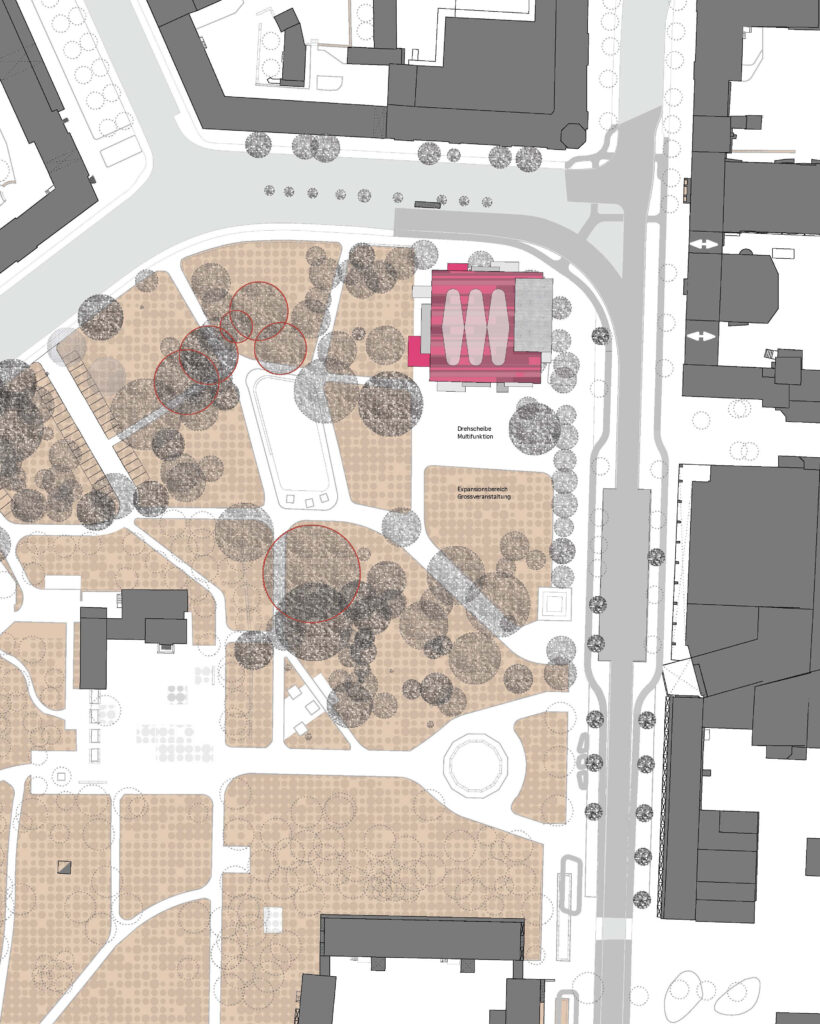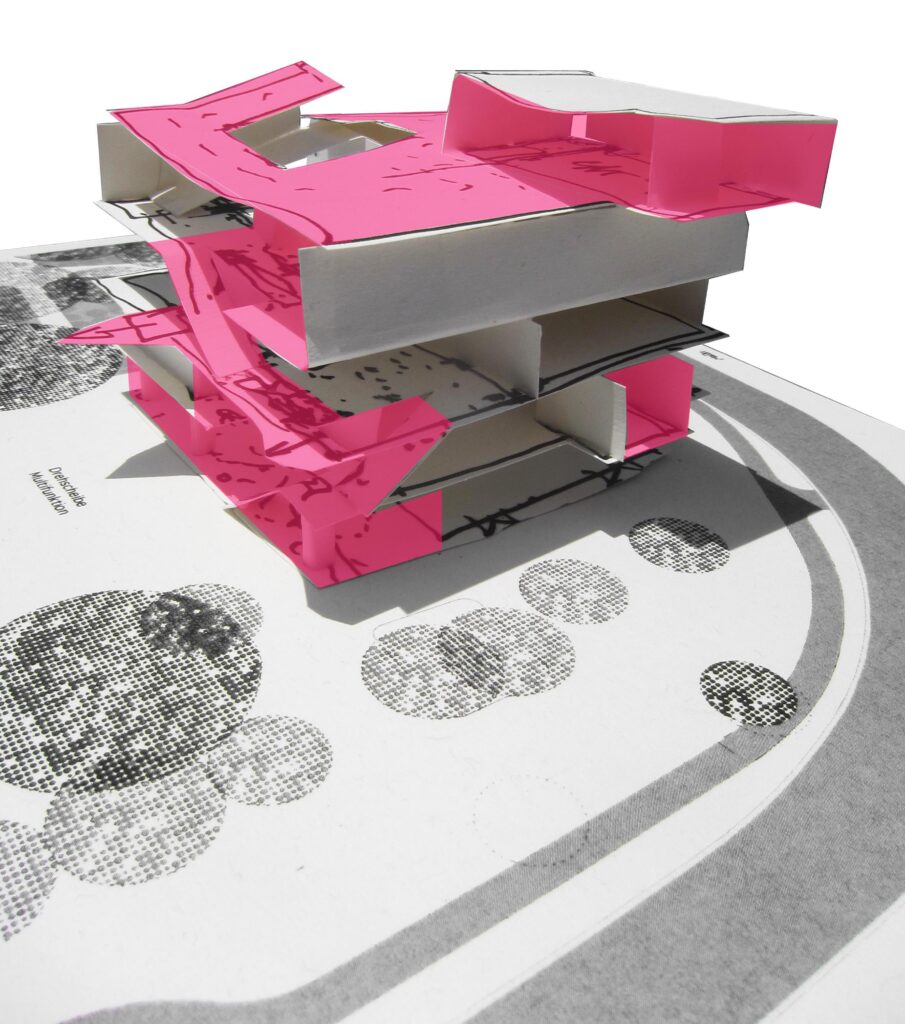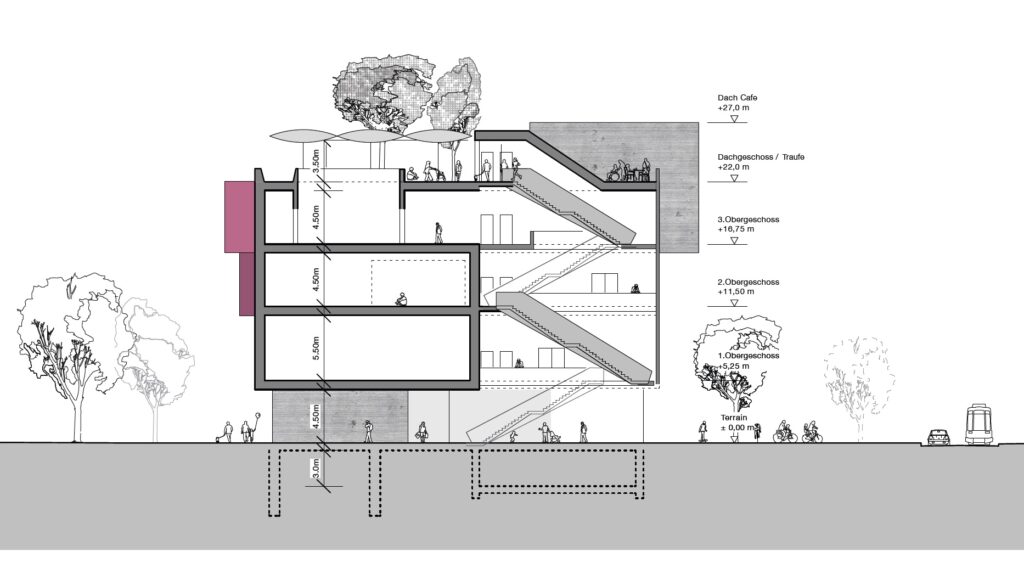


international competition: 2015
location: Dessau
Park Icon. The Bauhaus Museum as an icon in the park?
With the project for the new Bauhaus Museum in Dessau, the musealisation of the Bauhaus and the Bauhaus idea continues to progress. What was conceived, developed and produced in the historic Bauhaus and was in the service of revolutionary change in its own presentation is today to a large extent the subject of historical reappraisal, conservation and careful further development. This process moves between the poles of academic research, everyday and contemporary culture, as well as the logic of cultural consumption and location marketing.
Layers of different protective mechanisms have been laid over the historic Bauhaus buildings, regulated by monument protection, UNESCO and a critical and interested public. Despite the effective mechanisms of ossification, the Bauhaus building in Dessau has remained surprisingly adaptable and changeable. The fact that the building does not fulfil the technical requirements for a permanent exhibition is adequately explained by its age. The real reason, as we know, is that the Bauhaus building was conceived as a high-profile symbol of a progressive and forward-looking teaching and research institution and not as a museum.
With the construction of the Bauhaus buildings in Dessau in 1925, a promise of physical permanence was formulated after the move from Weimar, but this could not be realised in the intended form. The constellation of people and content at the Bauhaus was characterised by innovation and change – despite the affirmative manifesto and rigid curriculum. In this dual respect – spatially and in terms of inner constellations – the historic Bauhaus was less an institution than a provisional arrangement. A museum as a conservative and stationary institution does not self-evidently seem to fit in with this concept of the Bauhaus idea, which is characterised by external and internal dynamics. Is the previous practice of temporary exhibitions at different locations around the world not conceptually more consistent, not closer to the idea of the Bauhaus? The question arises as to whether a museum can do justice to the idea of the Bauhaus at all – after all, is it not the innovative research activities of the Foundation Academy, the (pausing) Studienkolleg, the interactions with the city, but also the everyday handling of the everyday objects produced according to Bauhaus models that keep the original idea of the Bauhaus alive for the present?
Musealisation as the production of a culture of memory and meaning goes hand in hand with the shifting of the respective context and the establishment of traditions. The reception of the Bauhaus idea developed along impulses that emanated from the Bauhaus and which – linked to very different individual biographies – found their way to unfold all over the world. The reception associated with an individual and specific place can therefore only become tangible in the overall context of the development of the Bauhaus idea. By invoking a universal tradition, it seems possible to build a bridge to the present and project the idea of the Bauhaus into the future beyond the obvious breaks in space, time and content. The extent of this desire to create continuity in this tradition is demonstrated by the architectural and material reconstructions of the recent past. However, building a bridge also means making the breaks to be bridged visible and tangible, emphasising discontinuities and recognising contradictions.
The idea of topoi as syntactic places that can be filled with changing content and create different references on a content level offers starting points for dealing with these conflicts. From here, it also seems possible to trace the crisis-ridden moments and contradictions of modernity and thus develop a critical-reflexive stance. Against this background, the architectural definition of the museum would have a difficult time if it attempted to represent the Bauhaus as an abstract idea, as an aesthetic or as history in any form. Such architectural endeavours are bound to fail because they fall short, are too immobile and cannot follow the changes of a critical appropriation of history. In a world characterised by signs and brands, it is precisely the obvious, legible messages that seem to exert the greatest attraction, but in the same way also the greatest opportunity for manipulation.
However, a museum building can – beyond the problematic intention of representation – above all be a building: a building that is filled with life through use, through different forms of appropriation, through the open and inviting gesture. A building that offers an appropriate environment for exhibits, but which, in contrast to the historic Bauhaus buildings, is not subject to a conservational framework and thus remains changeable in the future. A museum building can be a living building if it seeks points of connection that arise from the specific context and sets its own points of connection for this context. A museum building can be a source of inspiration for a centre that is gradually redefining itself after population decline and restructuring. A museum building can be defined by its content-related claim to international significance AND by its relationship to the everyday urban world in which it is embedded.
Such a building cannot be closed. High security and openness seem to contradict each other, but they can be combined. The secure, protective interior of the building is surrounded by an open, permeable shell. The concept of topoi and the open shell complement and confront the solid interior with the mobile and the temporary. They take up the idea of the provisional. A temporary structure does not unilaterally emphasise continuity (= enhancing the value of memory and meaning) and security (= exclusion). Rather, it acts as a condensation point for a lived diversity of interpretation and appropriation. The provisional nature of the museum building conceptualises the spatial framework not primarily as an architectural object, as a fixed setting, but as a space defined by use, as a processually produced space.
Precisely because the choice of location was controversially discussed and the decisive impulse came from outside, the success of the museum building will be measured not only by its characteristics as an exhibition building but also by how these characteristics are related to urban and cultural life in the city.
[submission text (engl. translation)]
